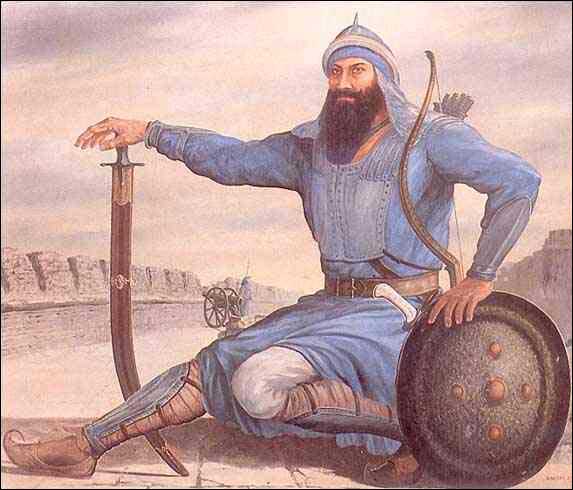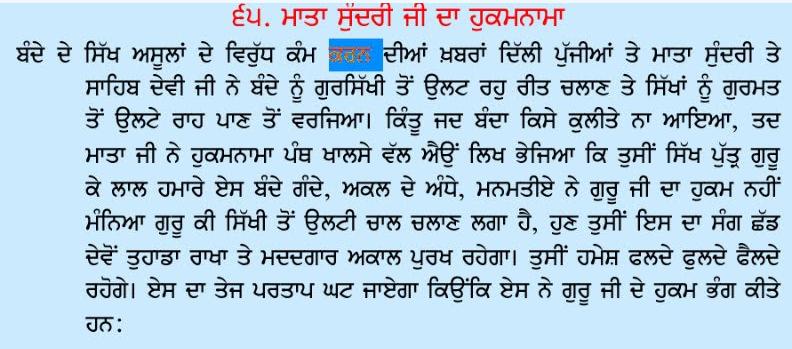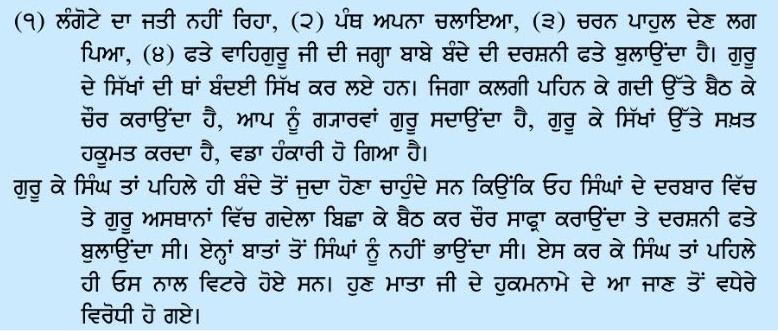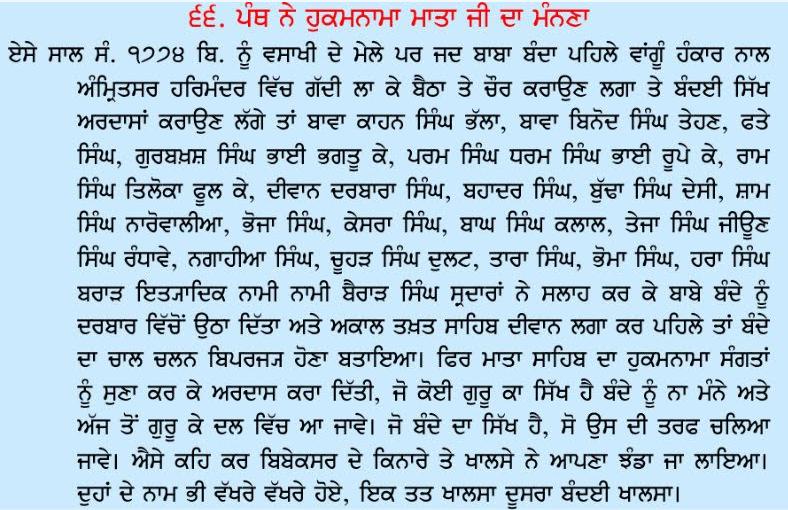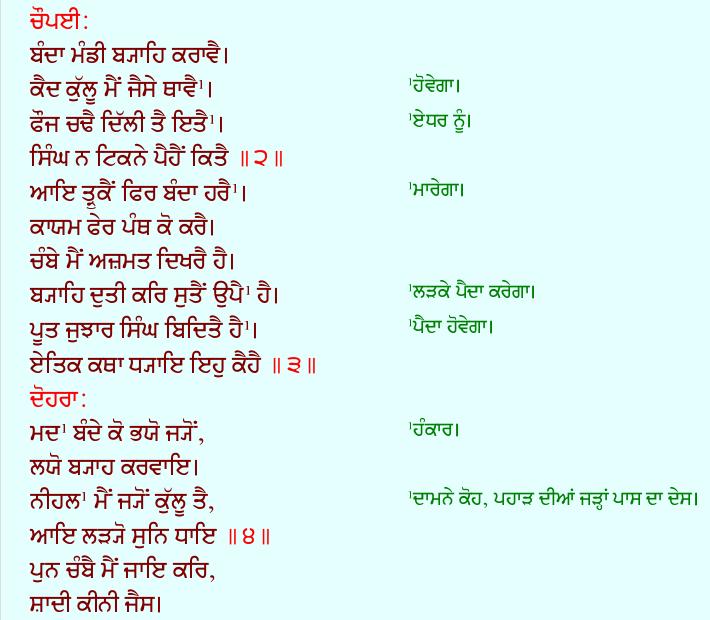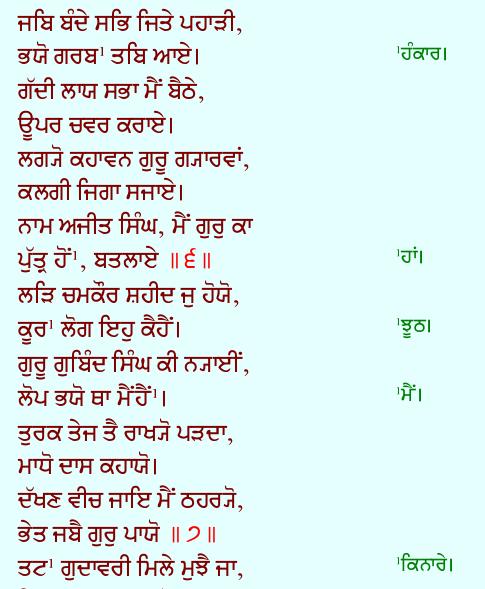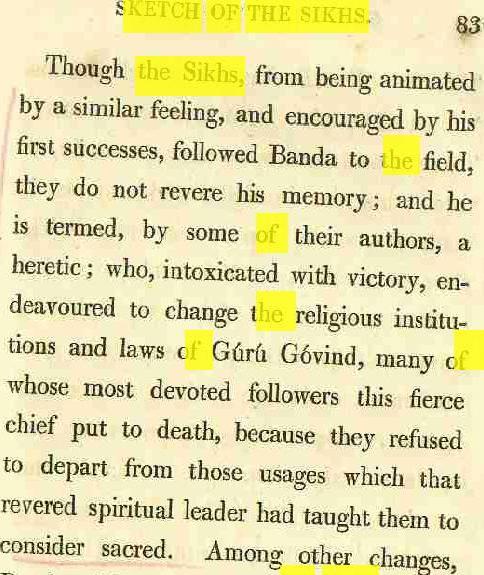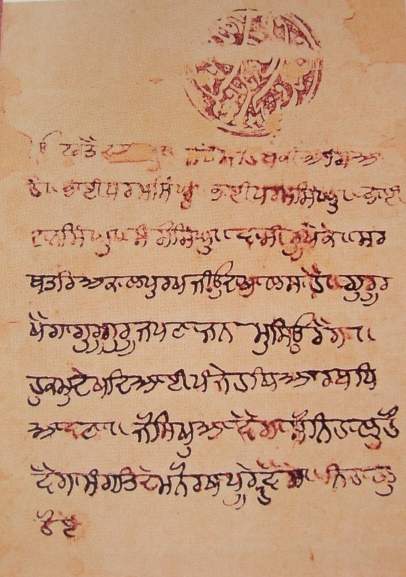Bandai Khalsa: Difference between revisions
No edit summary |
No edit summary |
||
| (42 intermediate revisions by 10 users not shown) | |||
| Line 1: | Line 1: | ||
''' | {{sectscults}} | ||
[[Bandai Khalsa]] is one of many Cults in Sikhi. '''Bandai Sikhs''' or '''Bandai Khalsa''', was the name given to the followers of [[Banda Singh Bahadur]] (1670 - 1716) that regarded the great military leader Banda Singh, as the Eleventh Guru, who followed Guru Gobind Singh Ji in an unbroken line of spiritual succession. Their sect originated around 1712, but the majority of Sikhs opposed their view; ultimately they were expelled from the Panth by the [[Tatt Khalsa]] in 1721. A small number of Bandai Sikhs still exist, they revere the Guru Granth Sahib Ji as their Scripture and most of them undergo the Khalsa initiatory rites, but they still hold to their belief that Banda Singh Bahadur Ji was their eleventh Guru. But the Mainstream Sikh belief is that the line of Human Sikh Gurus ended with [[Guru Gobind Singh]], the Tenth Master. | |||
[[Image:Banda_Singh_Bahadur.jpg|thumb|300px|right|Banda Singh Bahadur]] | [[Image:Banda_Singh_Bahadur.jpg|thumb|300px|right|Banda Singh Bahadur]] | ||
Guru Gobind Singh had | They share the common Sikh belief that Banda Singh Bahadur was sent to punjab by Guru Gobind Singh ji, to punish Wazir Khan and to preach Gurmat. He started establishing Raaj after shooking his hands with the Hill Rulers. He married with daughter of Hill Ruler o Chamba, with Ram Dei. He had power in hand and by misleading of Hill Rulers and relatives, he aimed on establishing Raaj. Guru Gobind Singh ji was with government during his last years of life and he also helped Bahadur Shah. He send Banda Singh with consent of Government, as government was already against Wazir Khan as he did various activities against government so centre allowed Khalsa to go sirhind and punish the convicts. | ||
And they say that later on, Banda Singh Bahadur ji even began to hold a Darbar, acting like a Guru in later stages. Banda Singh Bahadur Ji distorted the mission of the Khalsa neglecting the Sant part of the Sant-Sepahi tradition, established by Guru Gobind Singh at Anandpur Sahib. When government knew this that Banda Singh went against wishes and started establishing raaj, they outraged. Mata Sundri was also at delhi during that period. Even Sikhs who were send with Gobind Singh Binod Singh and Baj Singh left him due to his activities, which were against Hukam of Guru Ghar. Fort was seized at Gurdas Nangal and Tatt Khalsa came out of it on orders of Mata Sundri and Government. He want to stay in fort due to his reasons only and haven't agreed other sikhs. Neither he saved himself along with he take many. Tatt Khalsa escaped from fort as they knew that they will not survive. Banda had fight with Binod Singh and his brother and hurted his brother. | |||
Baba Binod Singh, one of 5 sikhs sent to accompany Banda, left Banda Singh's party and joined the Tatt Khalsa (Mata Sundri's side), when he was in the fort at Gurdas Nangal. Where government gave Hukamnama of capture Banda Singh and Sikhs, Mata Sundri also support government in delhi. She also excluded brother of Binod singh from Jatha of Bandai Sikhs. Later banda Bahadur was punished. He was tortured, according to Shariah of that time, and was killed. | |||
There are many confusing things concerning Banda's Rule, and questions from people of Tat Khalsa. | |||
* Why did he surrender to the Mughals, who had besieged him, and allow himself and his followers to be tortured and killed by the government acc. to their shariah? Khalsa never surrendered, either escape or fight against tyranny, but he surrendered. They were in hundreds, if we will compare this with Chamkaur battle or others then singh never surrendered, but he did. | |||
* From where Bandai Khalsa Emerge? From where this term came into existence? was he pretending as guru? | |||
* Where did the fateh Darshan slogan come from? even old hukamnamas available which contains term Fateh Darshan. | |||
* Few Folks asked the questions that If Government was in side of Banda Singh ji bahadur, Why was Mata Sundri never attacked during her stay at Delhi? Why mata Sundri gave hukamnama against Bandai Khalsa? <!--The fact by Harry is correct, the question is re-written--> | |||
* Why didn't she and the Tatt Khalsa try to save Banda Bairagi and bandai khalsas? | |||
* Although hill rulers were potential enemy of khalsa, why he shook his hands with them? Even he married with a daughter of one of Hill Ruler. | |||
* No record is their regarding celebration of any day linked to Banda singh in pst history. after 300 years Fateh Divas is celebrated first time at sirhind. | |||
Im Reality Banda Singh Bahadur never initiated any Bandai sikhs they even added that Gobind Singh said Banda singh to rule punjab and Mata Sundri was scared of government. So his history is quite confusing. Some of his positive works go in his favor like he made Coin on name of Nanak and he gave some of his life for Sikhs. But his latter life is not appreciated. | |||
Every Historical Sources is common on single point that he became Egoistic and wanted to become Guru. The Main Source of these claims the writer of Sri Gur Panth Prakash, was the grandson of Bhai Mehtab Singh of Mirankot, who was personally involved in the conflict between the Tat Khalsa and Bandai Khalsa thus his attitude towards Banda Singh Bahadur had been heavily influenced as such. However, his Sri Gur Panth Prakash is otherwise regarded as a magnum opus and used whereas Giani Gian Singh’s works are often rebuked for their fanciful nature, incorporating popular stories and narratives. | |||
Contemporary historians regard the Bandai Khalsa starting after the death of Banda Singh Bahadur but historical Sikh sources believe Banda Singh Bahadur went astray during the later phase of his life, growing egotistical and creating a cult around himself. Hence, for this reason, authors in the early 20th century such as Ganda Singh and Karam Singh Historian sought to analyse Banda Singh Bahadur through Persian sources as opposed to the traditional Punjabi sources. Balwant Singh Dhillon has carried this on, by analysing Banda Singh Bahadur through Rajasthani documents, allowing us access to his perception outside of the Sikhs. | |||
==Historical Sources against Banda Bahadur== | |||
===Mahankosh - Kahn Singh Nabha=== | |||
[[File:Banda_4_(Mahankosh).JPG|thumb|400px|center]] | |||
===Twarikh Guru Khalsa - Giani Gian SIngh=== | |||
[[File:Banda_1.JPG|thumb|400px|center]] | |||
[[File:Banda_2.JPG|thumb|400px|center]] | |||
[[File:Banda_3.JPG|thumb|400px|center]] | |||
===Panth Parkash=== | |||
[[File:Panth_Parkash_1.JPG|thumb|400px|center]] | |||
[[File:Panth_parkash_2.JPG|thumb|400px|center]] | |||
===Sketch of Sikhs=== | |||
‘Bandai Khalsa claimed that Banda Singh Bahadur ji wished that Sikhs abandon their blue dress, to refrain from drinking and eating flesh: and instead of exclaiming Wa! Guruji ki Futteh! Wa! Khalsaji ki Futteh! The salutations directed by Guru Gobind Singh ji, that he directed them to exclaim, Futteh D’herm! Futteh dersan! Which means, ‘Success to piety! Success to the sect!’ These innovations were very generally resisted: but the dreaded severity of Baba Banda Singh Bahadur, made many conform to his orders. The class of [[Akalis]], or Immortals, who had been established by Guru Gobind Singh Ji, continued to oppose the innovations with great obstinacy: and many of them suffered martyrdom, rather than change either their mode of salutation, diet or dress: and, at the death of Banda, their cause triumphed. All the institutions of Guru Gobind Singh Ji were restored.’ | |||
‘Sketch Of The Sikhs’, by J.C. Malcolm, 1812, P. 83 | |||
[[File:sketch of sikhs.jpg|thumb|center|300px|Sketch of Sikhs]] | |||
===Bharat Mat Darpan=== | |||
‘They initiate through ‘Charna Amrit’, keep ‘Janju’ (Hindu caste string signifying Brahmin lineage), wear white clothes, black or green clothes they never wear, they wear breaches coming below knee. On meeting they say, ‘Darshan Ji Ka Khalsa Darshan Ji Ki Fateh’. At the end of their name they either have title of Singh or Das.’ | |||
‘Bharat Mat Darpan’, by Pandit Ganesha Singh Nirmala, 1926, Pa. 234 | |||
==Fateh Darshan Hukamnama of Banda Singh Bahdur== | |||
[[File:hukmnama.jpg|thumb|center]] | |||
==Others== | |||
According to various Sikhs historical texts such as 'Pracheen Panth Prakash', 'Suraj Prakash', and Budha Dal oral tradition as told by the elderly Baba Mehr Singh, etc., Banda Bahadur, although a Sikh, was never initiated as Khalsa as modern Sikhs believe. According to orthodox Sanatan Sikh tradition and Budha Dal oral tradition as recounted in Pracheen Panth Prakash, over time,Baba Banda Singh Bahadur was overwhelmed with false pride and became arrogant. His mistreatment of the Khalsa, and alterations of the Guru-ordained Khalsa traditions, resulted in the Khalsa warriors loosing respect for him. Banda declared himself a Guru, advocated teetotalism (a throwback to his earlier life as a Vairagi), altered the Khalsa salutation, stopped wearing blue, etc. The mighty Akali Nihang Singh Khalsa, lead by Akali Nihang Baba Binod Singh and his son, Akali Nihang Baba Kahn Singh opposed these Hindu Vairagi innovations of Banda. Such was the fighting that the Akali Nihang warriors risked martyrdom in order to oppose Banda: | |||
Critical non emotional and unbiased Reasearch is needed on this side to expose the truth. | |||
==The Truth== | |||
Baba Banda Singh Bahadur did completely raze Sirhind to the ground. And then it was rebuilt solely by the Khalsa. The ‘Hukamnama’ by Mata Sundri has been debunked and it isn’t actually written by Mata Ji as the writing doesn’t match the other Hukamname. It’s also good to note that Baba Deep Singh Ji fought in every one of Baba Banda Singh’s wars up till Banda Bahadur’s capture. All Granths agree that the issue with Bandai Khalsa and Tat Khalsa arise after Baba Banda Singh’s Shaheedi. Baba Banda Singh never called himself Guru, wore red, told his followers to say Fateh Darshan or supported a full Vaishnu Diet. The ‘Hukamname’ written by Banda Singh have also been proved to be false. The original version of Panth Parkash written by Rattan Singh Bhangu does Mehima of Banda Singh. The edited version which was published in the early 1900s and is the most popular version today completely omits this information and instead vilifies Baba Banda Singh. I’ll make a more detailed post when I get time in the next few days. | |||
Baba Banda Singh never proclaimed himself to be the 11th guru while he was alive.Kesar Singh Chibber states in his bansavalinama that the proclamation of banda singh being the 11th guru happened after he had attained shaheedi.Banda Singhs own hukamnamahs also make a distinction between the personality of the guru and the personality of Banda singh,which shows us that banda singh isn't considering himself to be a guru. | |||
Guru Gobind Singh ji had given banda singh orders to punish the various corrupt government officials of punjab,and to establish a Sikh state over the punjab region.This explains why banda singh began to establish his own administration over the regions he had conquered.If banda singh was only focused on punishing wazir khan,then he would have stopped his rebellion as soon as sirhind was conquered.Yet after sirhind,banda singh would raid and conquer areas such as the Yamuna Ganga doaba,Jalandhar Doaba,and the Majha.This shows us that banda singhs aim was to free the Punjab region from mughal control and to establish sikh sovereignty over the region. | |||
The final thing to note is the excommunication of Baba Banda Singh by Mata Sundari.This has already been talked about by historians such as Ganda Singh,however there appears to be no contemporary or near contemporary sources that make mention of banda singh being excommunicated.The first source to make mention of this excommunication was rattan singh bhangu,who completed his work in 1841.Although most of the information bhangu provides is backed up by various contemporary records,his claim that mata sundari excommunicated banda singh has practically zero contemporary backing.No Mughal or Rajput contemporary records makes mention of some sort of conflict between banda singh and mata sundari.Other sikh sources such as the bansavalinama,suraj Prakash,and mahima Prakash make no mention of banda singh being excommunicated.This is one of the most common misconceptions regarding banda singh,which some Sikhs still believe in. | |||
Dr. Ganda Singh’s book on Baba Banda Singh’s life as it was his work and research that led to many disputed claims about Baba Banda Singh being finally resolved, followed by his complete re-integration into Sikh history. | |||
==Present Position== | |||
Nowadays, Bandais are a very niche community and only exist in certain pockets, one being in Jammu. Most of the followers of the Bandai dera are comprised of local Hindus, particularly Rajputs, or Khatris, both Hindu and Sikh. For the most part, the Sikh followers are indistinguishable between normal Sikhs. However, the more orthodox followers of the dera still obey by Mahant Fateh Singh’s decree of only marrying daughters to those who are in the Bandai sect. | |||
[[category:Sikh Cults]] | |||
Latest revision as of 12:27, 12 June 2024
| The article contains information about Sects and cults which evolved during times of gurus or later, having influence of Sikhism. These sects have many different philosophies from Gurmat or were made to put down real essence of Gurmat. These sects were not formed by any Gurus or Bhagats. If you have any comments, please discuss them here |
Bandai Khalsa is one of many Cults in Sikhi. Bandai Sikhs or Bandai Khalsa, was the name given to the followers of Banda Singh Bahadur (1670 - 1716) that regarded the great military leader Banda Singh, as the Eleventh Guru, who followed Guru Gobind Singh Ji in an unbroken line of spiritual succession. Their sect originated around 1712, but the majority of Sikhs opposed their view; ultimately they were expelled from the Panth by the Tatt Khalsa in 1721. A small number of Bandai Sikhs still exist, they revere the Guru Granth Sahib Ji as their Scripture and most of them undergo the Khalsa initiatory rites, but they still hold to their belief that Banda Singh Bahadur Ji was their eleventh Guru. But the Mainstream Sikh belief is that the line of Human Sikh Gurus ended with Guru Gobind Singh, the Tenth Master.
They share the common Sikh belief that Banda Singh Bahadur was sent to punjab by Guru Gobind Singh ji, to punish Wazir Khan and to preach Gurmat. He started establishing Raaj after shooking his hands with the Hill Rulers. He married with daughter of Hill Ruler o Chamba, with Ram Dei. He had power in hand and by misleading of Hill Rulers and relatives, he aimed on establishing Raaj. Guru Gobind Singh ji was with government during his last years of life and he also helped Bahadur Shah. He send Banda Singh with consent of Government, as government was already against Wazir Khan as he did various activities against government so centre allowed Khalsa to go sirhind and punish the convicts.
And they say that later on, Banda Singh Bahadur ji even began to hold a Darbar, acting like a Guru in later stages. Banda Singh Bahadur Ji distorted the mission of the Khalsa neglecting the Sant part of the Sant-Sepahi tradition, established by Guru Gobind Singh at Anandpur Sahib. When government knew this that Banda Singh went against wishes and started establishing raaj, they outraged. Mata Sundri was also at delhi during that period. Even Sikhs who were send with Gobind Singh Binod Singh and Baj Singh left him due to his activities, which were against Hukam of Guru Ghar. Fort was seized at Gurdas Nangal and Tatt Khalsa came out of it on orders of Mata Sundri and Government. He want to stay in fort due to his reasons only and haven't agreed other sikhs. Neither he saved himself along with he take many. Tatt Khalsa escaped from fort as they knew that they will not survive. Banda had fight with Binod Singh and his brother and hurted his brother.
Baba Binod Singh, one of 5 sikhs sent to accompany Banda, left Banda Singh's party and joined the Tatt Khalsa (Mata Sundri's side), when he was in the fort at Gurdas Nangal. Where government gave Hukamnama of capture Banda Singh and Sikhs, Mata Sundri also support government in delhi. She also excluded brother of Binod singh from Jatha of Bandai Sikhs. Later banda Bahadur was punished. He was tortured, according to Shariah of that time, and was killed.
There are many confusing things concerning Banda's Rule, and questions from people of Tat Khalsa.
- Why did he surrender to the Mughals, who had besieged him, and allow himself and his followers to be tortured and killed by the government acc. to their shariah? Khalsa never surrendered, either escape or fight against tyranny, but he surrendered. They were in hundreds, if we will compare this with Chamkaur battle or others then singh never surrendered, but he did.
- From where Bandai Khalsa Emerge? From where this term came into existence? was he pretending as guru?
- Where did the fateh Darshan slogan come from? even old hukamnamas available which contains term Fateh Darshan.
- Few Folks asked the questions that If Government was in side of Banda Singh ji bahadur, Why was Mata Sundri never attacked during her stay at Delhi? Why mata Sundri gave hukamnama against Bandai Khalsa?
- Why didn't she and the Tatt Khalsa try to save Banda Bairagi and bandai khalsas?
- Although hill rulers were potential enemy of khalsa, why he shook his hands with them? Even he married with a daughter of one of Hill Ruler.
- No record is their regarding celebration of any day linked to Banda singh in pst history. after 300 years Fateh Divas is celebrated first time at sirhind.
Im Reality Banda Singh Bahadur never initiated any Bandai sikhs they even added that Gobind Singh said Banda singh to rule punjab and Mata Sundri was scared of government. So his history is quite confusing. Some of his positive works go in his favor like he made Coin on name of Nanak and he gave some of his life for Sikhs. But his latter life is not appreciated.
Every Historical Sources is common on single point that he became Egoistic and wanted to become Guru. The Main Source of these claims the writer of Sri Gur Panth Prakash, was the grandson of Bhai Mehtab Singh of Mirankot, who was personally involved in the conflict between the Tat Khalsa and Bandai Khalsa thus his attitude towards Banda Singh Bahadur had been heavily influenced as such. However, his Sri Gur Panth Prakash is otherwise regarded as a magnum opus and used whereas Giani Gian Singh’s works are often rebuked for their fanciful nature, incorporating popular stories and narratives.
Contemporary historians regard the Bandai Khalsa starting after the death of Banda Singh Bahadur but historical Sikh sources believe Banda Singh Bahadur went astray during the later phase of his life, growing egotistical and creating a cult around himself. Hence, for this reason, authors in the early 20th century such as Ganda Singh and Karam Singh Historian sought to analyse Banda Singh Bahadur through Persian sources as opposed to the traditional Punjabi sources. Balwant Singh Dhillon has carried this on, by analysing Banda Singh Bahadur through Rajasthani documents, allowing us access to his perception outside of the Sikhs.
Historical Sources against Banda Bahadur
Mahankosh - Kahn Singh Nabha
Twarikh Guru Khalsa - Giani Gian SIngh
Panth Parkash
Sketch of Sikhs
‘Bandai Khalsa claimed that Banda Singh Bahadur ji wished that Sikhs abandon their blue dress, to refrain from drinking and eating flesh: and instead of exclaiming Wa! Guruji ki Futteh! Wa! Khalsaji ki Futteh! The salutations directed by Guru Gobind Singh ji, that he directed them to exclaim, Futteh D’herm! Futteh dersan! Which means, ‘Success to piety! Success to the sect!’ These innovations were very generally resisted: but the dreaded severity of Baba Banda Singh Bahadur, made many conform to his orders. The class of Akalis, or Immortals, who had been established by Guru Gobind Singh Ji, continued to oppose the innovations with great obstinacy: and many of them suffered martyrdom, rather than change either their mode of salutation, diet or dress: and, at the death of Banda, their cause triumphed. All the institutions of Guru Gobind Singh Ji were restored.’
‘Sketch Of The Sikhs’, by J.C. Malcolm, 1812, P. 83
Bharat Mat Darpan
‘They initiate through ‘Charna Amrit’, keep ‘Janju’ (Hindu caste string signifying Brahmin lineage), wear white clothes, black or green clothes they never wear, they wear breaches coming below knee. On meeting they say, ‘Darshan Ji Ka Khalsa Darshan Ji Ki Fateh’. At the end of their name they either have title of Singh or Das.’
‘Bharat Mat Darpan’, by Pandit Ganesha Singh Nirmala, 1926, Pa. 234
Fateh Darshan Hukamnama of Banda Singh Bahdur
Others
According to various Sikhs historical texts such as 'Pracheen Panth Prakash', 'Suraj Prakash', and Budha Dal oral tradition as told by the elderly Baba Mehr Singh, etc., Banda Bahadur, although a Sikh, was never initiated as Khalsa as modern Sikhs believe. According to orthodox Sanatan Sikh tradition and Budha Dal oral tradition as recounted in Pracheen Panth Prakash, over time,Baba Banda Singh Bahadur was overwhelmed with false pride and became arrogant. His mistreatment of the Khalsa, and alterations of the Guru-ordained Khalsa traditions, resulted in the Khalsa warriors loosing respect for him. Banda declared himself a Guru, advocated teetotalism (a throwback to his earlier life as a Vairagi), altered the Khalsa salutation, stopped wearing blue, etc. The mighty Akali Nihang Singh Khalsa, lead by Akali Nihang Baba Binod Singh and his son, Akali Nihang Baba Kahn Singh opposed these Hindu Vairagi innovations of Banda. Such was the fighting that the Akali Nihang warriors risked martyrdom in order to oppose Banda:
Critical non emotional and unbiased Reasearch is needed on this side to expose the truth.
The Truth
Baba Banda Singh Bahadur did completely raze Sirhind to the ground. And then it was rebuilt solely by the Khalsa. The ‘Hukamnama’ by Mata Sundri has been debunked and it isn’t actually written by Mata Ji as the writing doesn’t match the other Hukamname. It’s also good to note that Baba Deep Singh Ji fought in every one of Baba Banda Singh’s wars up till Banda Bahadur’s capture. All Granths agree that the issue with Bandai Khalsa and Tat Khalsa arise after Baba Banda Singh’s Shaheedi. Baba Banda Singh never called himself Guru, wore red, told his followers to say Fateh Darshan or supported a full Vaishnu Diet. The ‘Hukamname’ written by Banda Singh have also been proved to be false. The original version of Panth Parkash written by Rattan Singh Bhangu does Mehima of Banda Singh. The edited version which was published in the early 1900s and is the most popular version today completely omits this information and instead vilifies Baba Banda Singh. I’ll make a more detailed post when I get time in the next few days.
Baba Banda Singh never proclaimed himself to be the 11th guru while he was alive.Kesar Singh Chibber states in his bansavalinama that the proclamation of banda singh being the 11th guru happened after he had attained shaheedi.Banda Singhs own hukamnamahs also make a distinction between the personality of the guru and the personality of Banda singh,which shows us that banda singh isn't considering himself to be a guru.
Guru Gobind Singh ji had given banda singh orders to punish the various corrupt government officials of punjab,and to establish a Sikh state over the punjab region.This explains why banda singh began to establish his own administration over the regions he had conquered.If banda singh was only focused on punishing wazir khan,then he would have stopped his rebellion as soon as sirhind was conquered.Yet after sirhind,banda singh would raid and conquer areas such as the Yamuna Ganga doaba,Jalandhar Doaba,and the Majha.This shows us that banda singhs aim was to free the Punjab region from mughal control and to establish sikh sovereignty over the region.
The final thing to note is the excommunication of Baba Banda Singh by Mata Sundari.This has already been talked about by historians such as Ganda Singh,however there appears to be no contemporary or near contemporary sources that make mention of banda singh being excommunicated.The first source to make mention of this excommunication was rattan singh bhangu,who completed his work in 1841.Although most of the information bhangu provides is backed up by various contemporary records,his claim that mata sundari excommunicated banda singh has practically zero contemporary backing.No Mughal or Rajput contemporary records makes mention of some sort of conflict between banda singh and mata sundari.Other sikh sources such as the bansavalinama,suraj Prakash,and mahima Prakash make no mention of banda singh being excommunicated.This is one of the most common misconceptions regarding banda singh,which some Sikhs still believe in.
Dr. Ganda Singh’s book on Baba Banda Singh’s life as it was his work and research that led to many disputed claims about Baba Banda Singh being finally resolved, followed by his complete re-integration into Sikh history.
Present Position
Nowadays, Bandais are a very niche community and only exist in certain pockets, one being in Jammu. Most of the followers of the Bandai dera are comprised of local Hindus, particularly Rajputs, or Khatris, both Hindu and Sikh. For the most part, the Sikh followers are indistinguishable between normal Sikhs. However, the more orthodox followers of the dera still obey by Mahant Fateh Singh’s decree of only marrying daughters to those who are in the Bandai sect.
